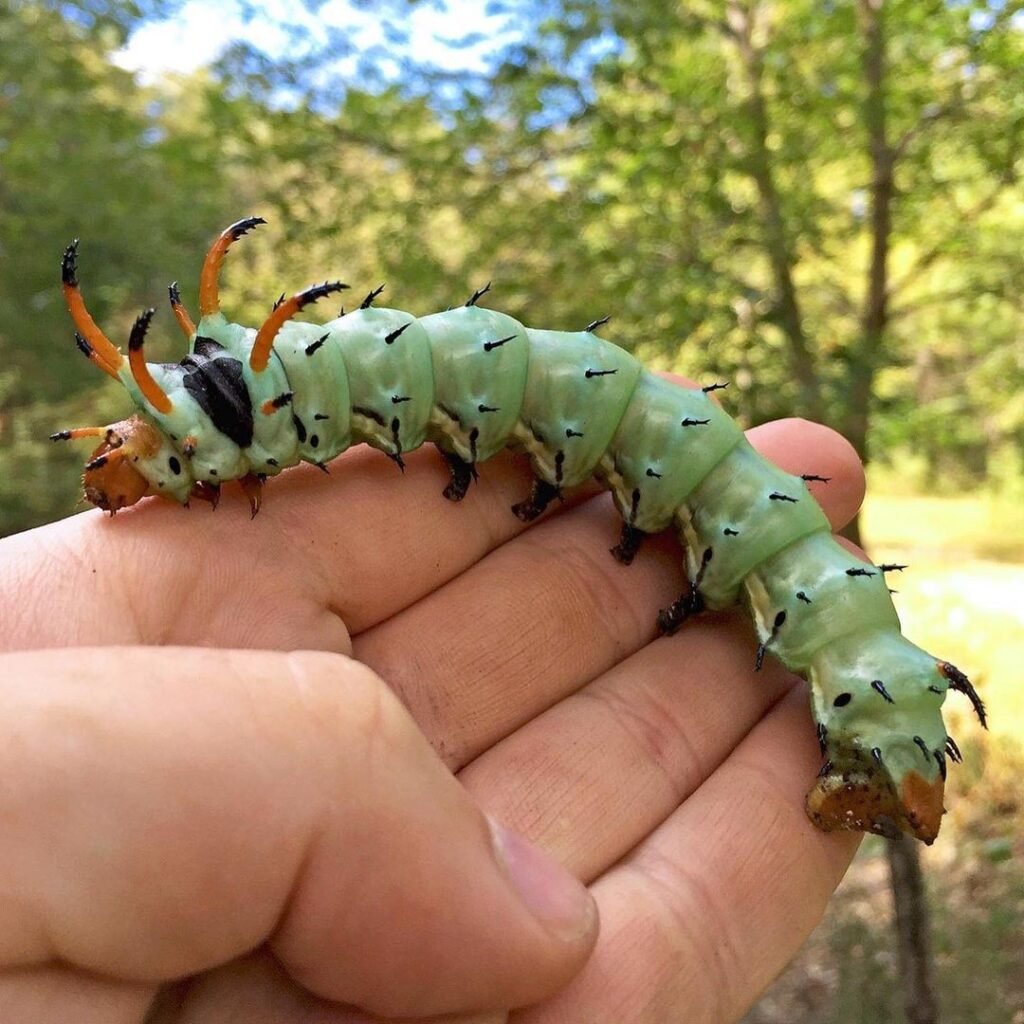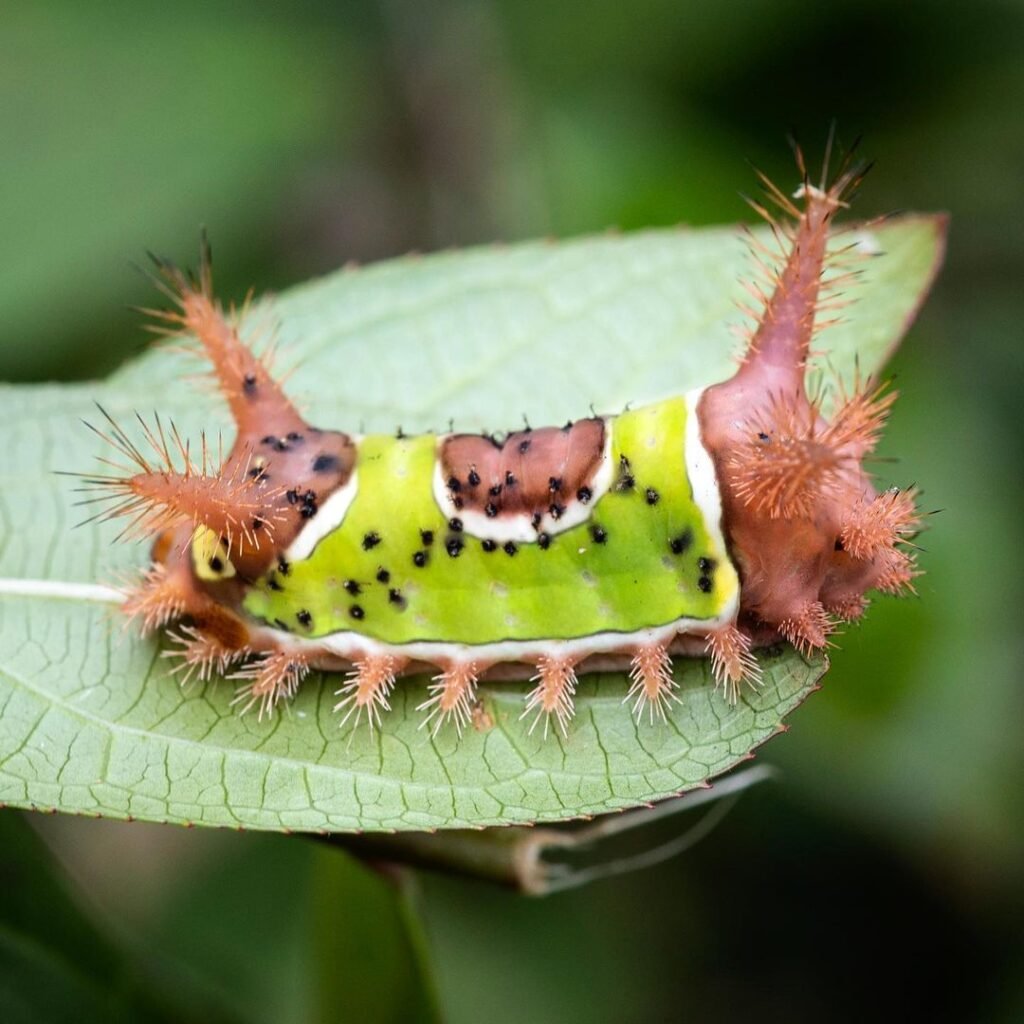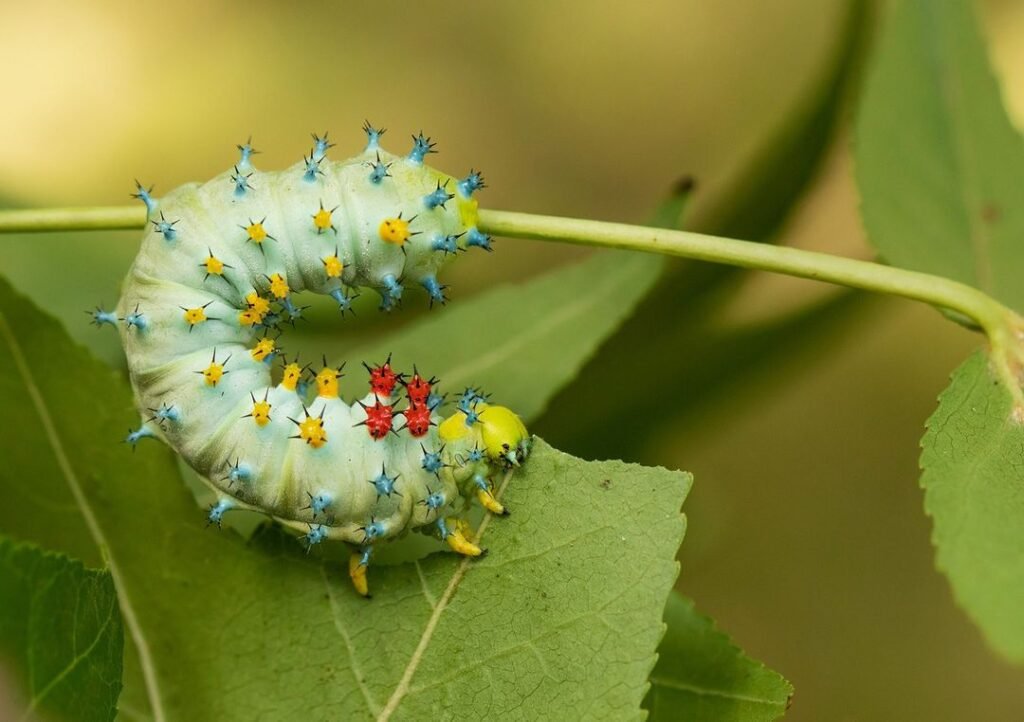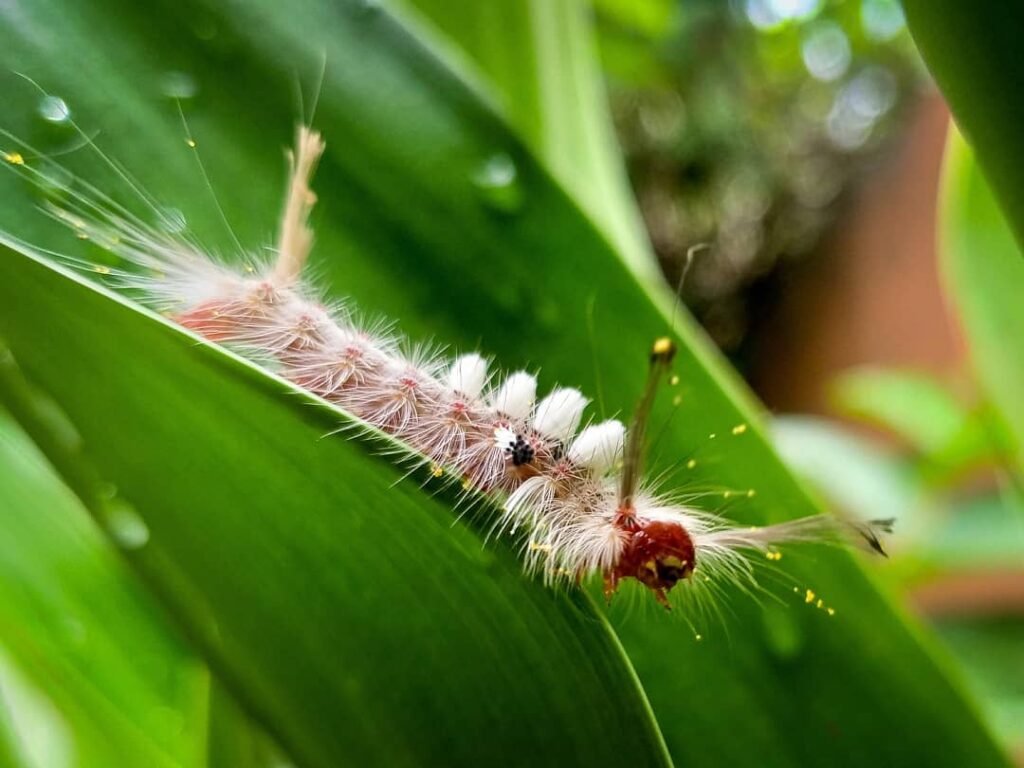Discover the captivating world of Texas Caterpillars with this comprehensive guide, featuring stunning pictures and detailed descriptions to help you identify 10 remarkable species, including hairy and fuzzy varieties.
The great state of home to a diverse array of is Texas caterpillars, each one a marvel of nature’s artistry. From the colorful and majestic to the hairy and fuzzy, these fascinating creatures come in all shapes and sizes, each with its own unique story to tell.
As a nature enthusiast or a curious observer, being able to identify these remarkable caterpillars can open up a whole new world of appreciation for the natural wonders that surround us. In this comprehensive guide, we’ll explore 10 captivating Texas caterpillars, complete with stunning pictures and detailed descriptions to help you recognize them in their natural habitats.
1. Io Moth Caterpillar

Here’s a detailed chart for the Io Moth Caterpillar:
| Category | Information |
|---|---|
| Scientific Name | Automeris io |
| Common Name | Io Moth Caterpillar |
| Life Stage | Larval (caterpillar) stage of Io Moth |
| Appearance | Bright green with white and red stripes running along its sides; covered in venomous spines (stinging hairs) |
| Size | 2-3 inches long when fully grown |
| Diet | Feeds on the leaves of various trees and plants, including willows, maples, oaks, and elms |
| Habitat | Deciduous forests, gardens, and wooded areas in North America (Eastern U.S., parts of Canada, and Mexico) |
| Behavior | Defensive; raises its spines when threatened. The venomous spines can cause a painful sting and irritation to humans. |
| Growth Habit | Goes through multiple instars (molts) as it grows before pupating into a cocoon |
| Special Features | Stinging spines serve as a defense mechanism; venom can cause a painful rash; adult Io Moth has eye-like spots on its hind wings to deter predators |
| Precautions | Avoid direct handling due to the stinging spines; wear gloves if contact is necessary |
The Io moth caterpillar is a true showstopper, adorned with striking colors and an unmistakable appearance. This remarkable creature boasts a vibrant green body with bright red stripes running along its sides, complemented by clusters of sharp, venomous spines protruding from each segment.
While these spines can deliver a painful sting, the Io moth caterpillar is generally harmless if left undisturbed. Its striking appearance serves as a warning to potential predators, ensuring its safety as it feeds on a variety of plants, including willows, cottonwoods and various fruit trees.
2. Hickory Horned Devil

Here’s a detailed chart for the Hickory Horned Devil:
| Category | Information |
|---|---|
| Scientific Name | Citheronia regalis |
| Common Name | Hickory Horned Devil |
| Life Stage | Larval (caterpillar) stage of the Regal Moth |
| Appearance | Bright green to bluish-green body with long, black, and orange spines (horns) on the head and thorax; can grow up to 5-6 inches long |
| Size | One of the largest caterpillars in North America, growing up to 5-6 inches long |
| Diet | Feeds on the leaves of hickory, walnut, pecan, sweetgum, sumac, and other deciduous trees |
| Habitat | Eastern and Southern United States; found in forests and wooded areas |
| Behavior | Despite its fierce appearance, the Hickory Horned Devil is harmless to humans and does not sting or bite |
| Growth Habit | Goes through several instars before burrowing into the ground to pupate and emerge as the Regal Moth |
| Special Features | Known for its large size and intimidating appearance; the spiny “horns” are purely for defense and are not venomous |
| Precautions | No specific dangers to humans, but handle gently if necessary due to its large size and fragile nature |
The Hickory Horned Devil is a true sight to behold, with its massive size and distinctive appearance. This impressive caterpillar can grow up to 5 inches in length, boasting a bright green body adorned with striking black and orange markings.
Perhaps its most remarkable feature is the pair of curved horns protruding from its head, earning it the “devil” moniker. Despite its intimidating appearance, the Hickory Horned Devil is harmless and is commonly found munching on the leaves of various hickory, walnut, and persimmon trees.
3. Spicebush Swallowtail Caterpillar

Here’s a detailed chart for the Spicebush Swallowtail Caterpillar:
| Category | Information |
|---|---|
| Scientific Name | Papilio troilus |
| Common Name | Spicebush Swallowtail Caterpillar |
| Life Stage | Larval (caterpillar) stage of the Spicebush Swallowtail Butterfly |
| Appearance | Early stages are brown and resemble bird droppings for camouflage; later stages are bright green with large eye spots on the thorax, mimicking a snake to deter predators |
| Size | Up to 2 inches long when fully grown |
| Diet | Feeds primarily on the leaves of spicebush (Lindera benzoin) and sassafras, but may also eat other laurel family plants |
| Habitat | Eastern North America, typically found in woodlands, gardens, and areas where host plants like spicebush and sassafras grow |
| Behavior | Rolls itself in leaves during the day for protection; emerges to feed primarily at night |
| Growth Habit | Goes through multiple instars; pupates in a chrysalis that varies in color (green or brown) depending on the season |
| Special Features | Eye spots mimic a snake’s head, helping deter predators; one of the few caterpillars that feeds on spicebush and sassafras |
| Precautions | Harmless to humans; no stings or toxins involved |
The Spicebush Swallowtail caterpillar is a true masterpiece of nature, with its intricate patterns and unique behaviors. This striking caterpillar features a bright green body adorned with large eye-like markings and a reddish-brown head.
When threatened, the Spicebush Swallowtail caterpillar can extend a pair of fleshy tentacles from behind its head, releasing a strong odor that can deter predators. These caterpillars feed exclusively on plants from the Laurel family, including spicebush, sassafras, and various citrus trees.
4. Saddleback Caterpillar

Here’s a detailed chart for the Saddleback Caterpillar:
| Category | Information |
|---|---|
| Scientific Name | Acharia stimulea |
| Common Name | Saddleback Caterpillar |
| Life Stage | Larval (caterpillar) stage of a moth |
| Appearance | Bright green body with a distinctive brown “saddle” mark on its back; covered in venomous spines that protrude from both ends of its body |
| Size | 1-1.5 inches long |
| Diet | Feeds on a variety of trees and shrubs, including oak, maple, willow, cherry, and corn |
| Habitat | Eastern United States; found in forests, gardens, and agricultural areas |
| Behavior | Slow-moving and easily noticeable due to its bold coloration; uses its venomous spines as a defense mechanism when touched |
| Growth Habit | Goes through several instars before pupating into a cocoon |
| Special Features | Venomous spines cause painful stings that can result in intense burning, swelling, and irritation; avoid direct contact |
| Precautions | Handle with extreme care or avoid handling altogether due to its painful sting; if stung, apply ice and seek medical attention if necessary |
The Saddleback caterpillar is a striking yet potentially dangerous creature that demands respect. Easily recognizable by its distinctive brown “saddle” marking on its back, this caterpillar is covered in a dense coat of venomous bristles that can cause severe irritation and even potential allergic reactions.
Despite its fearsome appearance, the Saddleback caterpillar is relatively small, measuring only about an inch in length. It feeds on a variety of trees and shrubs, including oak, maple, and azalea, so it’s important to exercise caution when encountering these creatures in the wild.
5. Buck Moth Caterpillar

Here’s a detailed chart for the Buck Moth Caterpillar:
| Category | Information |
|---|---|
| Scientific Name | Hemileuca maia |
| Common Name | Buck Moth Caterpillar |
| Life Stage | Larval (caterpillar) stage of the Buck Moth |
| Appearance | Black with rows of branched, venomous spines along its body; may have small white spots or yellow stripes depending on instar stage |
| Size | 2-3 inches long |
| Diet | Feeds on oak leaves, but can also eat willow, hazel, and other hardwood trees |
| Habitat | Found in the Eastern and Southern United States, particularly in oak forests and wooded areas |
| Behavior | When disturbed, the caterpillar raises its spiny body to deter predators; the spines can deliver a painful sting |
| Growth Habit | Undergoes several instars (molts) before pupating in the soil and emerging as an adult moth in the fall |
| Special Features | Venomous spines cause painful stings that can result in burning, swelling, and irritation; often found in groups, increasing the risk of multiple stings |
| Precautions | Avoid contact with the spines; if stung, apply ice and seek medical attention if severe reactions occur |
The Buck Moth caterpillar is a true Texas native, known for its striking black and white coloration and dense covering of bristly hairs. These caterpillars can be found munching on the leaves of various oak trees, where their distinctive appearance serves as a warning to potential predators.
While the hairs of the Buck Moth caterpillar are not venomous, they can cause skin irritation and allergic reactions in some individuals. These caterpillars are a fascinating sight, often gathering in large groups on tree trunks or branches, creating a captivating display of nature’s diversity.
6. Cecropia Moth Caterpillar

Here’s a detailed chart for the Cecropia Moth Caterpillar:
| Category | Information |
|---|---|
| Scientific Name | Hyalophora cecropia |
| Common Name | Cecropia Moth Caterpillar |
| Life Stage | Larval (caterpillar) stage of the Cecropia Moth |
| Appearance | Large, pale green body covered in blue, yellow, and orange tubercles (knobs) with black bristles; very distinctive and brightly colored |
| Size | Up to 4-5 inches long, one of the largest caterpillars in North America |
| Diet | Feeds on a variety of tree leaves, including maple, birch, cherry, and apple |
| Habitat | Found across the Eastern United States and parts of Canada in deciduous forests, woodlands, and suburban areas |
| Behavior | Slow-moving; spends most of its time feeding on leaves, growing larger before pupating in a tough cocoon attached to a tree branch |
| Growth Habit | Goes through several molts (instars) before pupating; transforms into the Cecropia Moth, the largest moth in North America |
| Special Features | The caterpillar is non-venomous and harmless to humans; bright colors and large size act as a deterrent to predators |
| Precautions | Harmless to touch, though delicate; can be handled gently but avoid unnecessary disturbance |
The Cecropia Moth caterpillar is a true giant among its kind, often reaching lengths of up to 4 inches. This remarkable caterpillar features a vibrant green body adorned with striking blue and yellow knobs, creating a truly eye-catching appearance.
the Cecropia Moth caterpillar is harmless and can be found feeding on a variety of trees, including maples, willows, and various fruit trees. These caterpillars are a delight to observe, their intricate patterns and gentle movements showcasing the beauty of nature’s design.
7. Polyphemus Moth Caterpillar

Here’s a detailed chart for the Polyphemus Moth Caterpillar:
| Category | Information |
|---|---|
| Scientific Name | Antheraea polyphemus |
| Common Name | Polyphemus Moth Caterpillar |
| Life Stage | Larval (caterpillar) stage of the Polyphemus Moth |
| Appearance | Bright green body with silver spots along its sides, short orange-colored knobs (tubercles) on the back, and sparse white bristles |
| Size | Can grow up to 3-4 inches long |
| Diet | Feeds on a wide variety of deciduous tree leaves, including oak, maple, birch, willow, and hickory |
| Habitat | Found across North America in forests, woodlands, and suburban areas |
| Behavior | Eats voraciously, growing quickly before spinning a silk cocoon, usually in leaves, where it will pupate |
| Growth Habit | Undergoes several molts before pupating into a cocoon; later emerges as the Polyphemus Moth, known for its large eyespots on the hindwings |
| Special Features | Harmless to humans; the large, green body and distinctive appearance are used to blend in with the surrounding foliage |
| Precautions | Completely harmless and can be gently handled, though it’s best to observe without disturbing it too much |
The Polyphemus Moth caterpillar is a true marvel of nature, boasting a striking appearance and impressive size. These caterpillars can grow up to 4 inches in length, featuring a vibrant green body adorned with intricate patterns of yellow, black, and reddish-brown markings. These caterpillars feed on a variety of tree leaves, including oak, maple and birch, making them a common sight in Texas woodlands and forests.
8. Sphinx Moth Caterpillar

Here’s information chart about the Sphinx Moth Caterpillar (Family: Sphingidae):
| Category | Details |
|---|---|
| Common Name | Sphinx Moth Caterpillar |
| Family | Sphingidae (Sphinx Moths) |
| Appearance | Varied, often resembling a thick-bodied worm or caterpillar; may have stripes, spots, or other markings; can range in color from green to brown or even pink |
| Size | Varies widely depending on species; can range from a few centimeters to several inches in length |
| Habitat | Diverse habitats including forests, fields, gardens, and urban areas |
| Range | Worldwide, with various species adapted to different regions and climates |
| Host Plants | Varied, depending on species; commonly includes members of the nightshade family (Solanaceae) such as tomatoes, peppers, and tobacco |
| Diet | Leaves of host plants |
| Defensive Mechanism | Varies; some species have camouflage resembling twigs or leaves, while others have spines or other deterrents |
| Pupation | Typically occurs in soil or leaf litter, where the caterpillar forms a cocoon for the transformation into a pupa |
| Adult Moth | Typically large, with a stout body and narrow wings; often capable of hovering in midair like a hummingbird |
| Activity | Varied, depending on species; some are active during the day (diurnal), while others are active at dusk or night (nocturnal) |
| Conservation | Varies by species; some are common and widespread, while others may be threatened by habitat loss, pesticides, or other factors |
| Interesting Fact | Sphinx moth caterpillars are often known for their rapid movement and voracious appetite; some species are important pollinators as adults |
The Sphinx Moth caterpillars are a diverse group of fascinating creatures, known for their unique shapes and often camouflaged appearances. These caterpillars can be found in various colors, ranging from shades of green to brown, allowing them to blend seamlessly with their host plants.
One of the most recognizable features of Sphinx Moth caterpillars is their distinctive “horn” or “tail” at the rear end, which is used for defense and communication. These caterpillars feed on a variety of plants, including tomatoes, tobacco, and various flowering shrubs,
9. Tussock Moth Caterpillar

Here’s information chart about the Tussock Moth Caterpillar (Family: Lymantriidae):
| Category | Details |
|---|---|
| Common Name | Tussock Moth Caterpillar |
| Family | Lymantriidae (Tussock Moths) |
| Appearance | Distinctive hairy or tufted appearance; often brightly colored with tufts or clusters of hairs along the body |
| Size | Varies depending on species; typically ranges from a few millimeters to several centimeters in length |
| Habitat | Diverse habitats including forests, woodlands, urban areas, and gardens |
| Range | Worldwide distribution, with various species adapted to different regions and climates |
| Host Plants | Varied, depending on species; commonly includes trees and shrubs such as oak, willow, and birch |
| Diet | Leaves of host plants |
| Defensive Mechanism | Some species have irritating or venomous hairs that can cause skin irritation or allergic reactions in humans; others rely on camouflage |
| Pupation | Typically occurs in a cocoon spun in a protected location, such as under bark or in leaf litter |
| Adult Moth | Often dull or inconspicuous in comparison to the caterpillars; females are usually flightless and lay eggs on or near host plants |
| Activity | Varied, depending on species; some are active during the day (diurnal), while others are active at night (nocturnal) |
| Conservation | Varies by species; some are common and widespread, while others may be threatened by habitat loss, pesticides, or other factors |
| Interesting Fact | Tussock moth caterpillars are often considered pests due to their habit of defoliating trees and shrubs; however, they also serve as important food sources for birds and other predators |
The Tussock Moth caterpillars are a group of hairy and fuzzy caterpillars that are easily recognizable by their distinctive tufts or “tussocks” of hair along their bodies. These caterpillars come in a range of colors, including shades of yellow, brown and gray, often with striking patterns and markings.
While some Tussock Moth caterpillars can be harmless, others possess venomous hairs that can cause skin irritation and allergic reactions. It’s important to exercise caution when encountering these caterpillars and avoid direct contact, especially with sensitive individuals or children.
10. Gulf Fritillary Caterpillar

Here’s information chart about the Gulf Fritillary Caterpillar (Agraulis vanillae):
| Category | Details |
|---|---|
| Common Name | Gulf Fritillary Caterpillar |
| Scientific Name | Agraulis vanillae |
| Family | Nymphalidae (Brush-footed Butterflies) |
| Appearance | Bright orange with black spines and rows of black dots along the body |
| Size | Up to 2 inches in length |
| Habitat | Various habitats including open fields, gardens, and areas with host plants |
| Range | Found throughout the southern United States, Central and South America |
| Host Plants | Passionflower vines (Passiflora spp.), especially maypop (Passiflora incarnata) and other related species |
| Diet | Feeds primarily on leaves of passionflower vines |
| Defensive Mechanism | None, relies on camouflage |
| Pupation | Pupates in a chrysalis, often attached to a nearby surface such as a stem or leaf |
| Adult Butterfly | Gulf Fritillary Butterfly; large, with a wingspan of 2.5 to 3 inches; bright orange wings with black markings and silver spots |
| Activity | Solitary; caterpillars are active during the day |
| Conservation | Not considered at risk, common within its range |
| Interesting Fact | The bright coloration of the caterpillar serves as a warning to predators of its toxicity, acquired from feeding on passionflower leaves |
The Gulf Fritillary caterpillar is a vibrant and captivating sight, adorned with striking orange and black stripes that serve as a warning to potential predators. These caterpillars feed exclusively on the leaves of passion vines, making them a common sight in gardens and landscapes throughout Texas.
Exploring the world of Texas caterpillars is an adventure in itself, offering a glimpse into the incredible diversity and beauty of nature. From the hairy and fuzzy to the colorful and majestic, each of these remarkable creatures has a unique story to tell, reminding us of the intricate tapestry of life that surrounds us.
Pingback: 10 Texas Caterpillars: A Visual Identification ...
Pingback: 10 Texas Caterpillars: A Visual Identification ...
Pingback: Caterpillars: Identification, Damag and Control Methods -
Pingback: Butterflies: The Ultimate Spotter’s Guide to Winged Wonders
Pingback: Caterpillars in California: Exploring the Diverse World